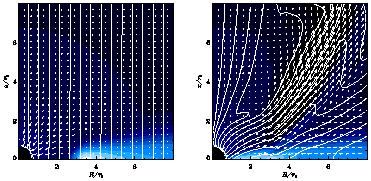


3.2 General Relativistic Simulations of Magnetized Disks in Kerr Geometry
Recent work by S. Koide, the author, and K. Shibata and T. Kudoh on general relativistic simulations of the accretion of magnetized material by black holes is beginning to provide a clearer picture of the development and evolution of a black hole magnetosphere and the resulting jet. Initial indications are that rapid rotation of the black hole and rapid infall of the magnetized plasma into this rotating spacetime both contribute to powerful, collimated, relativistic jet outflows. We find no evidence for buoyant poloidal field enhancement in the plunging region and, therefore, no reason to expect Schwarzschild holes to have a jet any more powerful than that estimated in Figure 1.

|
Figure 2. General relativistic simulation of a magnetized flow accreting onto a Kerr black hole (after Koide et al. 1999a). Left panel shows one quadrant of the initial model with the j = 0.95 hole at lower left, freely-falling corona, and non-rotating disk. The hole rotation axis (Z) is along the left edge. The initial magnetic field (vertical lines) is weak compared to the matter rest energy density (VA = 0.01 c). Right panel shows final model at t = 130 G MH / c3. Some of the disk and corona have been accreted into the hole, threading the ergosphere and horizon with magnetic field lines that develop a significant radial component, and hence an azimuthal component as well, due to differential frame dragging. The resulting jet outflow is accelerated by J x B forces to a Lorentz factor of 2.7. |
Figure 2 shows the initial and final state of a Kerr
(j = 0.95) black hole simulation with a weak
(VA  Bp /
Bp /  (4
(4

 disk =
0.01 c) magnetic field and an inner edge at Rin
= 4.5 G MH / c2. For more
details see
Koide et al. (1999a).
In this first simulation the disk
was non-rotating, and so began to free-fall into the ergosphere
(at Rergo = 2 GMH /
c2) as the calculation proceeded. As with other
MHD disk simulations
(Kudoh & Shibata 1995,
Ustyugova et al. 1995,
Ouyed & Pudritz 1997,
Meier et al. 1997),
the field lines were wound up by differential rotation and a hollow jet
of material was ejected along the poloidal field lines by the
J x B forces; here the jet velocity was
rather relativistic (vjet ~ 0.93c or
disk =
0.01 c) magnetic field and an inner edge at Rin
= 4.5 G MH / c2. For more
details see
Koide et al. (1999a).
In this first simulation the disk
was non-rotating, and so began to free-fall into the ergosphere
(at Rergo = 2 GMH /
c2) as the calculation proceeded. As with other
MHD disk simulations
(Kudoh & Shibata 1995,
Ustyugova et al. 1995,
Ouyed & Pudritz 1997,
Meier et al. 1997),
the field lines were wound up by differential rotation and a hollow jet
of material was ejected along the poloidal field lines by the
J x B forces; here the jet velocity was
rather relativistic (vjet ~ 0.93c or
 ~ 2.7). However,
as the disk was initially non-rotating, all the action was due to the
differential dragging of frames by the rotating black hole. Little or no
jet energy was derived from the binding energy of the accreting material or
its Keplerian rotation.
~ 2.7). However,
as the disk was initially non-rotating, all the action was due to the
differential dragging of frames by the rotating black hole. Little or no
jet energy was derived from the binding energy of the accreting material or
its Keplerian rotation.
As a control experiment, the same simulation was also run with a Schwarzschild (j = 0) hole. The collapse developed a splash outflow due to tidal focusing and shocking of the inflowing disk, but no collimated MHD jet occurred.
We also studied counter-rotating and co-rotating Keplerian disks with otherwise similar initial parameters (Koide et al. 1999b). The counter-rotating case behaved nearly identically to the non-rotating case: because the last stable retrograde orbit is at Rms = 9 G MH / c2, the disk began to spiral rapidly into the ergosphere, ejecting a strong, black-hole-spin-driven MHD jet. On the other hand, for prograde orbits Rms = G MH / c2, so the co-rotating disk was stable, accreting on a slow secular time scale. At the end of the calculation (tmax = 94 G MH / c3), when the simulation had to be stopped because of numerical problems, the disk had not yet accreted into the ergosphere and had produced only a weak MHD jet. Future evolution of this case is still uncertain. The Keplerian Schwarzschild case was previously reported by Koide et al. (1998) and developed a moderate sub-relativistic MHD jet similar to the aforementioned simulations of magnetized Keplerian flows around normal stars, plus a pressure-driven splash outflow internal to the MHD jet.
In the Kerr cases we see significant magnetic field enhancement over the Schwarzschild cases due to compression and differential frame dragging. It is this increase that is responsible for the powerful jets ejected from near the horizon. In the Schwarzschild cases, on the other hand, - particularly in the Keplerian disk case in Koide et al. (1998) - we do not see any MHD jet ejected from well inside Rms. That is, we do not see any increase in jet power that could be attributed to buoyant enhancement of the poloidal field in the plunging region. While there is a jet ejected from inside the last stable orbit, it is pressure-driven by a focusing shock that develops in the accretion flow. The magnetically-driven jet that does develop in the Schwarzschild case emanates from near the last stable orbit as expected, not well inside it. It is therefore concluded that a powerful MHD jet will be produced near the horizon if and only if the hole is rotating rapidly.